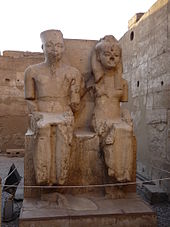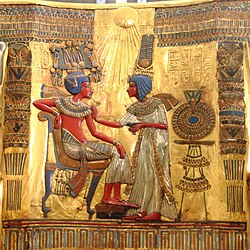Ankhesenamun
| Ankhesenamun in hieroglyphics | ||||||||
|---|---|---|---|---|---|---|---|---|
Anchesenamun (Anches en Amun) ˁnḫ = sn Jmn She lives for Amun |
||||||||
Anchesenpaaton (Anches en pa Aton) ˁnḫ = sn p3 Jtn She lives by Aton / She lives for Aton |
||||||||
|
Tutankhamun and Ankhesenamun on a throne from the tomb of Tutankhamun ( Cairo Egyptian Museum ) |
||||||||
Anchesenamun , also Anches-en-Amun , originally Anchesenpaaton or Anches-en-pa-Aton , was the great royal wife of the ancient Egyptian king ( Pharaoh ) Tutankhamun and the third daughter of King Amenophis IV (Akhenaten) and his great royal wife Nefertiti . Ankhesenamun was born in Akhenaten's 5th or 6th year of reign and, according to the inscriptions, was given the name "Ankhesenpaaton".

After the death of her sisters, and probably even before the death of Semenchkare , Ankhesenpaaton married her half-brother / brother Tutanchaton (Tutankhamun) . After the coronation of Tutankhaten to Pharaoh, both initially remained in the capital of the late Akhenaten, the sun city Akhetaten ( 'Horizon of Aten "), today Amarna . A few years later the capital was relocated to Memphis and Achet-Aton was abandoned as a residence. The names of both royal children were changed, like that of Amenhotep to Akhenaten. Tutanchaton was now called Tutankhamun and Ankhesenpaaton's name was changed to Ankhesenamun.
Based on the various images of the royal couple found in Tutankhamun's tomb , the sibling marriage is considered consensual and loving. However, this type of representation can also be traced back to previous art from the Amarna period , in which the royal family was always represented in an idealized manner.
The two fetuses found in the tomb of Tutankhamun ( KV62 ) in the Valley of the Kings are considered daughters of Ankhesenamun and Tutankhamun. The two children are a premature birth from the 5th month of pregnancy and a stillbirth from the 8th month. Genetically it could be established that the stillborn children of Tutankhamun and the mummy are KV21A . However, this mummy could not be identified as Ankhesenamun and Akhenaten's daughter.
Eje succeeded Tutankhamun on the throne and possibly married Ankhesenamun, since both names are mentioned together on two rings that are in the Egyptian Museum in Berlin. As a result, this marriage would have served to legitimize Eje's rule, since he was not of royal blood from Akhenaten's lineage. Anchesenamun is not mentioned in writing after Tutankhamun's death, nor is she mentioned as Eje's wife in his grave ( WV23 ). Her grave is unknown.
In connection with the controversial Dahamunzu affair , it is assumed that after Tutankhamun's death, Ankhesenamun asked the Hittite prince Šuppiluliuma I for a son as husband. He should have become king because she wanted to prevent Eje from taking over as the last remaining member of the Akhenaten royal family.
literature
- Dorothea Arnold , Lyn Green, James Allen: The Royal Women of Amarna. Images of Beauty in Ancient Egypt. Metropolitan Museum of Art / Distribution: Harry N. Abrams, New York 1996, ISBN 0-87099-818-8 , pp. 11-12.
- Aidan Dodson , Dyan Hilton : The Complete Royal Families of Ancient Egypt. Thames & Hudson, London / New York 2004, ISBN 0-500-05128-3 , p. 154.
- Joyce Tyldesley : The Queens of Ancient Egypt. From the early dynasties to the death of Cleopatra. Koehler & Amelang, Leipzig 2008, ISBN 978-3-7338-0358-2 , pp. 137-139.
Web links
- Part 2 - Who was Tutankhamun? with some pictures of the "couple" and extensive explanations of the situation at that time
- Signet ring of the Anchesenpaaton
Individual evidence
- ^ Zahi Hawass: Discovering Tutankhamun. From Howard Carter to DNA. The American University Press, Cairo 2013, ISBN 978-977-416-637-2 , p. 170.
| personal data | |
|---|---|
| SURNAME | Ankhesenamun |
| BRIEF DESCRIPTION | Wife of Tutankhamun |
| DATE OF BIRTH | 14th century BC Chr. |
| DATE OF DEATH | 14th century BC Chr. |
